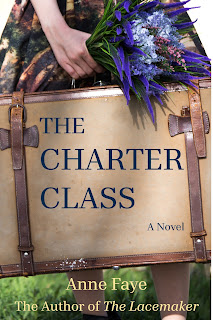The Story Behind "The Charter Class"
 |
| The Charter Class is now available on Amazon |
Our Lady of the Elms first opened as an academy to educate girls in Chicopee, Massachusetts, in 1899. The diocese purchased a large home and property on Springfield Street to accommodate the new institution. The school was named in honor of the Blessed Mother and for the number of stately elm trees growing on the property. The Sisters of St. Joseph of Springfield, who had been serving the Diocese of Springfield since 1883, staffed the institution. It operated as a boarding school designed for girls from economically modest families, especially one-parent households, in addition to welcoming local students who could commute to school on a daily basis. While it doesn’t factor in this novel, the academy for younger students would coexist with the college until 1944.
By 1910, the sisters established a Normal School, known as St. Joseph’s College, as an outgrowth of the academy, a two-year course of study that would prepare students to be teachers. A chapel was built in 1913. It served the Elms community for many years until it was demolished in 2016 due to structural concerns.
Margaret Frances Aloysia Somers was born in Ireland on September 23, 1873. Her family moved to Troy, New York, and then to North Adams, Massachusetts. She entered the Sisters of St. Joseph on July 24, 1890, at the age of sixteen, and was given the religious name of John Berchmans. On September 1, 1911, she was named Mother Superior of the community.
 | |
| Mother John Berchmans Somers |
Bishop Thomas O’Leary was born in 1875 in Dover, New Hampshire. He became Bishop of Springfield on May 10, 1921, at the age of forty-six.
 |
| Bishop Thomas O'Leary |
The relationship between Bishop O’Leary and Mother John Berchmans was cordial. In Mother John Berchman’s first meeting with her new bishop, she brought up her dream of beginning the College of Our Lady of the Elms, a four-year liberal arts institution. According to Sister Consuelo Maria Aherne, S.S.J. in Joyous Service: The History of the Sisters of Saint Joseph of Springfield, Mother John Berchmans would “let the Bishop ‘perfect it and take all the credit.’”
While Mother John Berchmans needed Bishop O’Leary’s approval and support, she was the true force behind the effort. She gathered information, visited other colleges, and made sure that the members of her religious community were prepared to teach at the college level, sending them for advanced study at Fordham, Boston College, Manhattan College, and Providence College.
In 1923, construction began on O’Leary Hall, which would house classrooms, a library, and dormitory for the new students. On January 26, 1928, a state charter was granted for the College of Our Lady of the Elms. O’Leary Hall still exists as does the Administration Building which was under construction in this story. It was later renamed Berchmans Hall in honor of the college’s foundress.
 |
| O'Leary Hall and The College of Our Lady of the Elms Chapel |
While Bishop O’Leary and Mother John Berchmans are historical figures, the other sisters in this book are purely fictional. A 1929 list of faculty working at the school includes Sr. Mary Baptista as the Superior, Sr. Helen Joseph, Sr. Mary Cornelius, Sr. Teresa Marie, Sr. Mary Cecilia, and Sr. St. Macharia.
The students are also products of my imagination, but the events in this story are loosely based on “The Diary of Peggy Pip” included in the 1932 Elmata, the yearbook of the graduating charter class.
While this is a fictional story based on the development of a particular Catholic women’s college located in Chicopee, Massachusetts, it also represents the larger tale of women religious who began colleges throughout the country, opening the doors of higher education to young women at a time when that was still a rare opportunity. It is also a tale of those young women who were diving into unchartered waters in an era when society and many of their families did not expect them to pursue a college education. (By way of comparison, my own grandmothers, who lived at the same time, left school at the age of fourteen to go to work.) The world, however, was changing for young women, and these students were determined to find their place in it.
The future students who would walk the halls of the College of Our Lady of the Elms owe the Sisters of St. Joseph and the original class a debt of gratitude for the wonderful foundation that they laid.
Sources
Sister Consuelo Maria Ahearne, S.S.J., Joyous Service: The History of The Sisters of Saint Joseph of Springfield (Sisters of St. Joseph, 1983).
Thomas Moriarty, Ph.D., “History of Our Lady of the Elms: Founding and Early Years,” Tribute to History: Our Lady of the Elms Annual Report 1998-1999 (Chicopee: Our Lady of the Elms, 1999).
1932 Elmata, https://archive.org/details/elmata1932ourl/
The Digital Commonwealth site has some wonderful material on the history of The College of Our Lady of the Elms. https://www.digitalcommonwealth.org/institutions/commonwealth:rj430g71j

Comments
Post a Comment